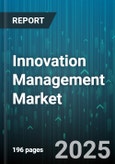Speak directly to the analyst to clarify any post sales queries you may have.
Innovation management software is redefining how enterprises collaborate and drive change, offering senior decision-makers integrated solutions that align digital innovation with core business strategy. These platforms empower organizations to adapt, streamline ideation, and sustain long-term growth through cohesive, data-driven processes.
Market Snapshot: Growth and Trajectory of the Innovation Management Software Market
The innovation management software market is experiencing dynamic expansion, projected to increase from USD 2.99 billion in 2024 to USD 3.89 billion by 2025. With a compound annual growth rate of 30.17%, the market is expected to approach USD 24.64 billion by 2032. This momentum is driven by heightened organizational demand for integrated platforms that support seamless ideation, advanced collaboration, analytics, and structured governance. Leading solution providers are expanding their offerings, leveraging sophisticated analytics, strategic alliances, and a variety of deployment models. As organizations face rapidly evolving regulatory and market landscapes, these innovations are enabling greater adoption across global enterprises.
Scope & Segmentation of the Innovation Management Software Market
- Component: Solutions encompass consulting, open innovation program design, process and model development, integration, customization, migration services, analytics, moderation, project management, scouting, and end-user training. Software components address collaboration, crowdsourcing, idea management, analytics, KPI tracking, portfolio and roadmapping tools, as well as technology scouting and trend analysis.
- Pricing Model: Models available include enterprise agreements, freemium editions, perpetual and subscription licenses, user- or usage-based pricing, and options based on API activity.
- Organization Size: Modular offerings scale to both large enterprises and small to mid-sized businesses, supporting strategic oversight or operational agility.
- Deployment Mode: Choices extend to private and public cloud, hybrid systems, and on-premises infrastructure to support diverse compliance and data control requirements.
- Application: Platforms enable co-creation, hackathons, design thinking, crowdsourcing (internal and external), partner engagement, knowledge sharing, IP and idea discovery, patent landscaping, project tracking, stage-gate automation, R&D management, scenario planning, and engagement with startups.
- End-Use Industry: Adoption spans aerospace, defense, automotive, financial services, chemicals, education, energy, utilities, food and beverage, government, healthcare, IT, telecom, logistics, manufacturing, media, entertainment, retail, consumer goods, travel, and hospitality sectors.
- Region: The market encompasses the Americas (including the United States, Canada, Brazil, and Mexico), Europe, the Middle East and Africa (covering major economies and rising hubs), and Asia-Pacific (leveraging strong adoption trends in China, India, Japan, Australia, and Southeast Asia).
- Key Companies: Major providers include Planview, Brightidea, HYPE Innovation, Qmarkets, IdeaScale, Wazoku, Imaginatik, Exago Software, Ideanote, and SAP SE.
Key Takeaways for Senior Decision-Makers
- Unified digital platforms facilitate the alignment of strategic goals with daily operations by enabling collaborative workflows across departments and geographies.
- Regulatory requirements and data privacy concerns drive organizations to select from a suite of deployment models that fit risk and compliance profiles.
- Artificial intelligence, machine learning, and analytics help organizations surface emerging trends, screen ideas efficiently, and optimize resource allocation, supporting resilience.
- Scalability and security are prioritized by larger organizations, while smaller organizations often select flexible subscription-based or cloud-native solutions tailored for rapid deployment.
- Industries such as financial services and healthcare demand added layers of data security and regulatory compliance, influencing solution customization and vendor selection.
- Vendor partnerships and acquisitions are increasing, which can strengthen integration capabilities and expand service offerings to meet wider business requirements.
Tariff Impact and Market Adaptation
Recent U.S. tariff policy shifts have led organizations with on-premises systems to reevaluate total costs, resulting in a move toward public, private, or hybrid cloud deployments. This migration aims to optimize capital expenditures while enhancing operational efficiency. To address labor and input cost fluctuations, vendors are offering more predictable pricing models. Despite changing cost structures, organizations maintain a focus on resilience and adaptability as regulatory environments evolve.
Methodology & Data Sources
This analysis is based on structured interviews with executive, product, and IT leaders, further supported by rigorous market intelligence, regulatory analysis, and case study validation. Triangulation and external validation methods underpin the report’s reliability for enterprise decision-making.
Why This Report Matters for Executives in Innovation Management
- Supplies segmented, actionable intelligence to align software investments with strategic outcomes across varying industries and regions.
- Equips leaders with frameworks to anticipate compliance requirements and choose deployment strategies that deliver sustained business value.
- Supports data-driven technology adoption that strengthens regulatory compliance and operational performance amidst continual technological evolution.
Conclusion
Innovation management software is at the heart of digital transformation strategies. This report provides senior leaders with practical analysis to guide successful technology adoption and support resilient, competitive growth.
Additional Product Information:
- Purchase of this report includes 1 year online access with quarterly updates.
- This report can be updated on request. Please contact our Customer Experience team using the Ask a Question widget on our website.
Table of Contents
3. Executive Summary
4. Market Overview
7. Cumulative Impact of Artificial Intelligence 2025
Companies Mentioned
The companies profiled in this Innovation Management market report include:- Planview, Inc.
- Brightidea, Inc.
- HYPE Innovation GmbH
- Qmarkets Ltd.
- IdeaScale, Inc.
- Wazoku Ltd.
- Imaginatik, Inc.
- Exago Software, Lda.
- Ideanote ApS
- SAP SE
Table Information
| Report Attribute | Details |
|---|---|
| No. of Pages | 196 |
| Published | October 2025 |
| Forecast Period | 2025 - 2032 |
| Estimated Market Value ( USD | $ 3.89 Billion |
| Forecasted Market Value ( USD | $ 24.64 Billion |
| Compound Annual Growth Rate | 30.1% |
| Regions Covered | Global |
| No. of Companies Mentioned | 11 |









